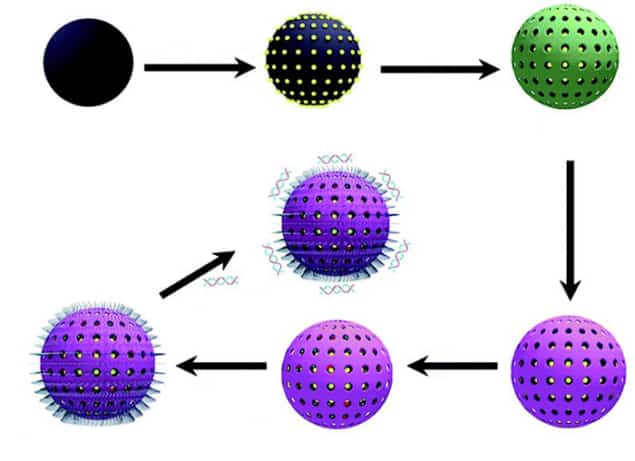
Cancer is a complex disease to treat, and yet the operating principle of many current treatments is to simply kill healthy cells a little slower than cancerous ones. In response, scientists at The University of Electronic Science and Technology of China have developed a sophisticated nanoparticle-based treatment. Their theranostic nanoparticles carry an anti-cancer drug cargo, and showcase multiple cutting-edge nanomedicine technologies to enhance the drug’s efficacy, including selective drug delivery, photoactive agents, and even signal-jamming genetic material.
The researchers have designed each individual nanoparticle to be a toolbox for cancer therapy, able to passively and actively target tumours (Biomater. Sci. 2017 Advance Article). The nanoparticles can act as contrast agents for both magnetic resonance imaging and X-ray, they deliver a concentrated dose of anti-cancer drugs, and they also thwart the cancer’s attempts at developing immunity to the drug. They even deliver a photosensitizer that can be used to specifically weaken cancerous tissue by photodynamic treatment.
Yiyao Liu and colleagues demonstrated the efficacy of their nanodevices in vitro and in vivo on a range of cell lines and on tumours in living mice. They found that their nanoparticle drug-delivery technique effectively stopped tumour growth, whereas tumours in mice treated with the drug alone grew at a rate half that of a control group that had not been treated.
The nanoparticles are complex, many layered spheres. Protected by a jacket of natural polymer is a nugget of silica, holey like a sponge and soaked in doxorubicin, a common anti-cancer drug, along with the photosensitizer. The polymer jacket is pH sensitive so that it falls off in the acidic microenvironment of the tumour, only then releasing the active cargo.
Doxorubicin has two flaws. Firstly, it works by slotting in-between DNA base pairs to stop the replication process needed for cells to divide. This kills cells that need to duplicate quickly, such as cancerous cells, but harms many healthy cell types too. Secondly, it triggers the body’s natural defences, causing cells to over express p-glycoprotein, a microscale pump that removes toxic molecules like doxorubicin from cells, and making the drug less and less effective against cancer.
The scientists at The University of Electronic Science and Technology of China countered both of these flaws. Healthy cell exposure is reduced by the polymer jacket, which makes sure the drug is only released under the conditions expected in a tumour. The jacket itself is covered in signal-jamming RNA to inhibit the expression of the cellular pumps, keeping the doxorubicin trapped inside the cells to allow the drug to work for longer. This impressive display of multifunctional nanoparticle design and synthesis demonstrates the power of nanomedicine for producing synergistic effects, offering new solutions to previously unsurmountable problems.



